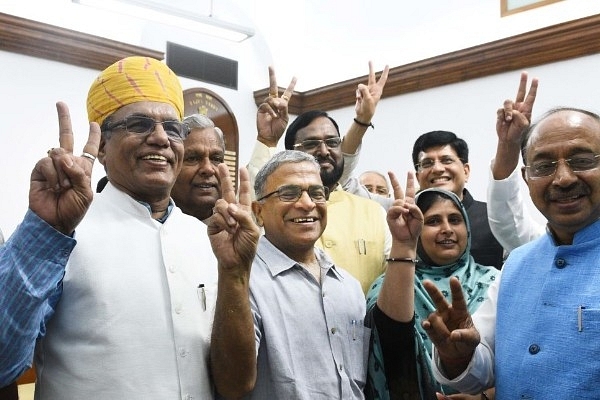
What The NDA’s Rajya Sabha Victory Tells Us About Its Prospects For 2019
The Rajya Sabha victory shows that the BJP is on the inside track in the race for 2019. The only question is whether it will win on its own, or will need allies.
The National Democratic Alliance (NDA) candidate for Rajya Sabha Deputy Chairman, Janata Dal (United)’s Harivansh, coasted to victory yesterday (9 August) with a 125-105 margin. This performance, which is the result of keeping the NDA flock more or less together, and additionally getting non-NDA parties to vote for Harivansh, indicates that both Narendra Modi and Amit Shah are realists – and preparing for a possible coalition in 2019 in case the Bharatiya Janata Party (BJP) falls short of a majority on its own. If the BJP’s Lok Sabha seat count drops to the 200-220 range, it will need two large coalition partners with 20-30 seats each, and two more with chunks of five to 10 to reach the magic number of 272.
In itself, the election of the Rajya Sabha Deputy Chairman is not very important, especially when the Chairman is a staunch BJP man, Venkaiah Naidu. But the process of wooing new allies and sowing discord in the United Progressive Alliance/opposition ranks was important, and that is essentially what this election achieved.
For Rahul Gandhi and the opposition, the problem is that their internal contradictions are greater than that of the NDA, given that they are largely an amorphous grouping of state parties plus the Congress. In the states, regional parties are often ranged against the Congress or one another, making a seamless, pan-India Mahagathbandhan (grand alliance) tough to negotiate. At best, we will get limited regional alliances blocking the BJP in crucial states like Uttar Pradesh, but elsewhere, the alliance tends to fray as regional animosities tend to dominate.
Here is a state-wise break-up of what the BJP could face in electorally significant states in 2019:
Uttar Pradesh: It will be Bahujan Samaj Party (BSP) plus Samajwadi Party (SP) and the Congress. This state will be the toughest to crack for the BJP, which won one-quarter of its seats here.
Bihar: It could be JD(U) plus Lok Janshakti Party and BJP versus Rashtriya Janata Dal and Congress, with smaller parties joining one or the other fronts. It is an even battle as of now.
Jharkhand: It will be BJP versus the rest.
West Bengal: It could be Trinamool plus Congress versus BJP and Left Front. Mamata Banerjee has the edge, but the BJP will be hoping to grab three to four seats.
Odisha: It will be Biju Janata Dal versus BJP versus Congress. The BJP is expected to make gains, but not a breakthrough.
Punjab: It will be a three-way fight, with BJP-Akali Dal ranged against Congress (perhaps with BSP) and Aam Aadmi Party (AAP). AAP could shrink.
Delhi: It will again be a three-way fight, with AAP expecting to score some gains as against the BJP’s clean sweep of seven seats in 2014. A covert understanding between AAP and Congress cannot be ruled out.
Haryana: It could be Congress versus Indian National Lok Dal versus BJP, with the BJP losing some ground, especially in Jat seats.
Maharashtra: This is a crucial state, especially since Shiv Sena has been an estranged ally of the BJP. The BJP will have to give the Sena more seats than what it can win to keep its ally quiescent. The ultimate combos will still be BJP plus Sena plus the Republican Party of India (Athawale) versus Congress and Nationalist Congress Party, along with smaller farm-based parties.
Karnataka: It will be Janata Dal (Secular) plus Congress versus BJP.
Telangana: It will be Telangana Rashtra Samithi versus the rest, with the BJP at best being a contender in one seat.
Andhra Pradesh: It will be a four-way contest, with Telugu Desam Party fighting YSR Congress, Congress, and BJP. The Congress could manage a covert seat adjustment with either YSR or TDP, but no alliance.
Kerala: It will be the usual Left Democratic Front versus United Democratic Front match, with the BJP seeking to score a higher vote share, and possibly win one seat.
Tamil Nadu: It will be a multi-party contest, with Dravida Munnetra Kazhagam (DMK) being the main pole. The All India Anna Dravida Munnetra Kazhagam (AIADMK) is widely expected to splinter either before or after the elections, and the performance of new entrants like Rajinikanth and Kamal Haasan will be watched with interest. The BJP will focus on two or three winnable seats and hope to tie up with the ultimate winner.
Gujarat, Madhya Pradesh, Chhattisgarh, Rajasthan, Himachal Pradesh, Uttarakhand: These states will be straight fights between the Congress and the BJP, with smaller parties, especially the BSP, playing marginal roles.
Jammu and Kashmir: The Congress and National Conference will seek to gain here, with the BJP trying hard to hold on to its seats in Jammu.
North-East and Sikkim: The BJP will seek to win most seats along with allies and proxies, except in Assam, where it will seek to, at least, retain the seats it won in 2014.
Goa: The BJP and regional parties will face the Congress in a straight contest for two seats.
The BJP’s route to power in 2019 depends on the following parties doing well in 2019: TRS, BJD, YSR Congress, AIADMK/Rajinikanth. Current allies like JD(U), LJP, Shiv Sena, and Akali Dal, apart from some of the smaller parties in the Hindi belt and the North East, also need to put up a decent show. All of them will demand a greater share of power if the coalition wins. It will not be a repeat of 2014.
Parties that could swing either way include DMK, NCP, and JD(S), apart from many single-MP parties.
The Rajya Sabha victory shows that the BJP is on the inside track in the race for 2019. The only question is whether it will win on its own, or will need allies.